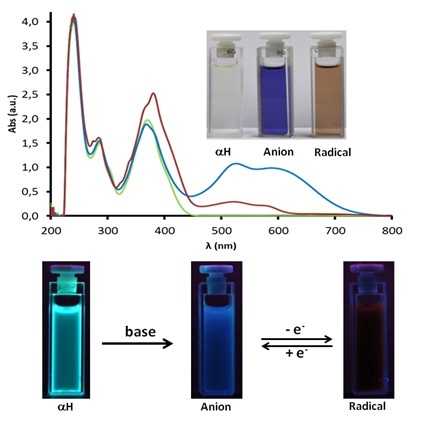Riccardo Frisenda, Rocco Gaudenzi, Carlos Franco, Marta Mas-Torrent, Concepció Rovira, Jaume Veciana, Isaac Alcon, Stefan T. Bromley, Enrique Burzurí, Herre S. J. van der Zant
Nano Lett., 2015, 15 (5), pp 3109–3114
It is shown that the paramagnetism of the polychlorotriphenylmethyl (PTM) radical molecule in the form of a Kondo anomaly is preserved in two- and three-terminal solid-state devices, regardless of mechanical and electrostatic changes. Indeed, reported evidences demonstrate that the Kondo anomaly is robust under electrodes displacement and changes of the electrostatic environment pointing to a localized orbital in the radical as the source of magnetism. Strong support to this picture is provided by DFT calculations and measurements of the corresponding non-radical species. These results pave the way towards the use of all-organic neutral radical molecules in spintronics devices and open the door to further investigations into Kondo physics.

Four Glove Dispensing isolator for expermiments with highly active and cytotoxic compounds.
Description: The four-glove isolator is a safe chamber, with controlled environment for the weighing and handling of potent drug compounds.
Technical specifications: The Isolator has been designed to offer containment to a working OEL (Occupational Exposure Limit) of less than 0.1Jgrams/m³ time weighted average over an 8hr operational period (TWA).
The Isolator is designed to offer an internal air cleanliness of Class 8 as described in ISO 14644-7 and the test pass criteria is a leakage rate of ≤0.25% vol/hr and is in line with Class 2 classification of ISO 14644-7.
Applications:
Pharmaceutical Manufacturing: In pharmaceutical manufacturing, especially for the production of potent drugs or active pharmaceutical ingredients (APIs), a 4-glove isolator can be used for containment. It helps in preventing cross-contamination and ensures the safety of both the product and the operator.
Biotechnology Research: In research laboratories working with hazardous biological materials such as viruses, bacteria, or genetically modified organisms (GMOs), a 4-glove isolator provides a secure environment for manipulation and experimentation. It minimizes the risk of exposure to harmful agents.
Sterile Compounding: In compounding pharmacies and hospital pharmacies, a 4-glove isolator can be utilized for sterile compounding of medications. It helps in maintaining aseptic conditions, preventing contamination, and ensuring the safety and efficacy of compounded drugs.
MicroCal VP-ITC – Malvern
Description:
Isothermal titration calorimetry (ITC) measures the binding affinity and thermodynamics between two biomolecules. When substances bond, heat is released or absorbed. Measuring this heat change in an ITC experiment allows precise determination of the binding constants (KD), stoichiometry (n), enthalpy (ΔH) and entropy (ΔS), providing a complete thermodynamic profile of the molecular interaction in a single experiment.
The MicroCal VP-ITC system is a powerful, sensitive and easy-to-use calorimeter that offers the possibility of investigating any biomolecular interaction. This rapid, convenient, label-free, and solution-based technique provides the information needed to characterize the molecular interactions of proteins, antibodies, nucleic acids, and other biomolecules.
Technical specifications:
• Cell type: Non-reactive Hastelloy
• Sample volume 2 mL
• Volume per cell: 1.4 mL
• Volume injected: 0.3 mL
• Mixing speed: user selectable
• Response time: user selectable
• Working temperature: 2º to 80º C
Applications:
• Characterization of molecular interactions of proteins, antibodies, nucleic acids and other biomolecules.
• Kinetic enzyme.
• Evaluation of the effect of molecular structural changes on binding mechanisms.
• Evaluation of biological activity.
The Junta de Gobierno of the Real Sociedad Española de Química agreed to approve the Award for Excellence in Research RSEQ 2015 to Dr. Concepció Rovira Angulo in recognition of his outstanding contributions to chemistry, embodied in conceptual developments and studies on multifunctional molecular materials, particularly electronic and / or magnetic properties.
His interdisciplinary research has a substantial effect on the development of nanoscience and molecular nanotechnology. Dr. Concepció Rovira is Research Professor of CSIC, under the Department of Molecular Nanoscience and Organic Materials Institute of Materials Science of Barcelona (ICMAB-CSIC). Recently, he has been awarded the “2013 Distinguished Women in Chemistry” IUPAC Prize.
She is the author of over 300 publications, over 50 in the last five years, with very strong presence in the most important journals in the field of materials and notorious visibility in multidisciplinary chemistry with high impact factor with tens of publications (Journal of the American Chemical Society / Angewandte Chemie / Chemical Science / Nature Chemistry), 8 of them in the last five years. She is the author of numerous patents, including two international and another in operation. In the last five years it has been principal investigator of three European projects and other with state funding; in that five-year period, he has given more than 30 lectures at conferences and national and international centres of research. He has directed 13 doctoral theses, 3 in the last five years.

C. Franco, M. Mas-Torrent, A. Caballero, A. Espinosa, P. Molina, J. Veciana and C. Rovira
Chemistry A european Journal, 2015, 21, 5504 – 5509 DOI: 10.1002/chem.201405993
Two new pyrene-polychlorotriphenylmethyl (PTM) dyads and triads have been synthesized and characterized by optical, magnetic and electrochemical methods. The interplay between the different electronic states of the PTM moiety in the dyads and triads and the optical and magnetic properties of the molecules have been studied. The electronic spectra of the radicals show the intramolecular charge-transfer (ICT) transition at around 700 nm due to the acceptor character of the PTM radical. In the diamagnetic protonated derivatives, the fluorescence due to the pyrene is maintained, whereas in the radicals and the corresponding anions there is a clear quenching of the fluorescence. The redox activity of PTM radicals that are easily reduced to the corresponding carbanion has been exploited to fabricate electrochemical switches with optical and magnetic response.

Cardiac electrophysiology lab with navigation (CARTO 3) and biotherapeutics delivery (NOGA XP) systems.
